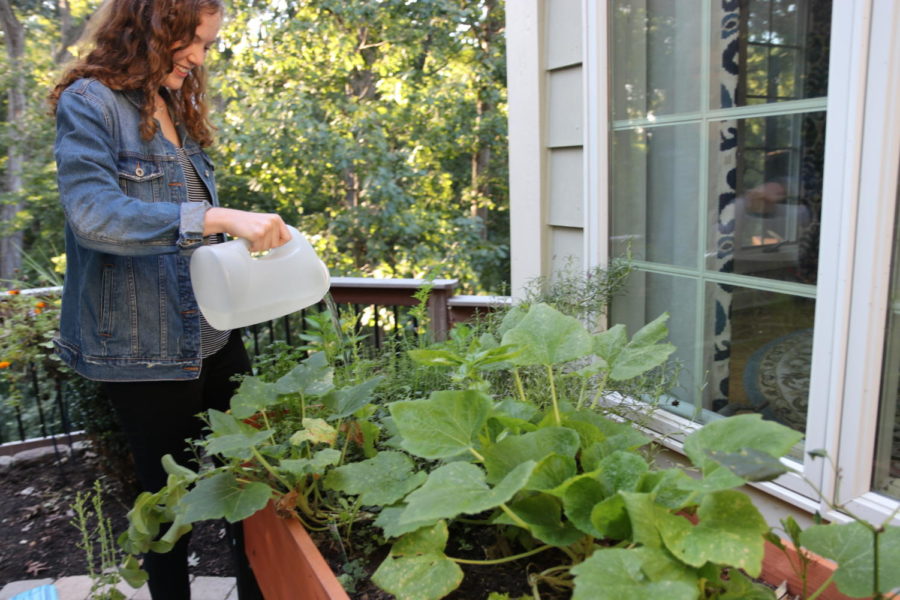Your donation will support the student journalists of Marquette High School. Your contribution will allow us to purchase equipment and cover our annual website hosting costs. You may become a PATRON by making a donation at one of these levels: White/$30, Green/$50, Blue/$100. Patron names will be published in the print newsmagazine, on the website and once per quarter on our social media accounts.
Environmental Concerns Provoke Action
December 6, 2019
Media by Kavya Jain
Abby Grace, senior, waters a variety of herbs and green on her deck. Grace’s family started gardening last year and have since incorporated their harvest into their diet. “The whole problem is everyone has that negative mentality sometimes that they can’t make an impact, but the best way to get around that is to make changes in your own life,” Grace said.
Is this an ethical brand? Are they using sustainable resources?
These were senior Abby Grace’s thoughts as she was looking for a Homecoming dress.
Her sustainability efforts are incorporated throughout her life, especially in her purchasing habits as she nears college independence. The decision to buy a Homecoming dress became more complicated as Grace considered its environmental implications.
However, she recognizes some sustainable brands aren’t necessarily economical, so Grace suggested thrift shopping as an ecologically-friendly alternative with a unique selection.
She is also environmentally conscious regarding her food choices and meal preparation. Grace packs her lunch four times a week, and she recently started using only Tupperware and reusable utensils. She said she struggles with the fact that this isn’t realistic for everyone.
“Not everyone can bring their lunch or have reusable utensils,” Grace said. “That’s why it’s so important for the school to take those steps because it can’t always come from the students when they don’t have those resources.”
Once administration and staff takes steps for food sustainability and informs students about the topic, Grace said, students are likely to continue these practices outside of school.
Grace said a reading in her AP Environmental textbook was encouraging and serves as a motivation for her to continue her efforts as an individual.
“It said that it only takes 5-10 percent of a group of people in a population to make a change or significant impact,” Grace said.
She said individual’s action should be simple and lightly planned, such as turning off lights when reasonable, lessening shower time or walking more often.
Food and Waste
Grace and her family have expanded their environmental contributions to composting and gardening.
“By composting, you’re reducing your landfill waste, and you’re able to return what you’re eating back into the earth,” Grace said. “My dad has started growing a lot of our vegetables, and we’re starting to incorporate that into our diets.
Kevin Koch, environmental science teacher, said food waste at school is a major concern.
“If you look in the cafeteria, the trash cans are full of food waste,” Koch said. “I know other school districts in the area have multiple avenues where you have landfill bins, a place for recycling and another container for compost. I know we have reusable red trays. But with the styrofoam plates, what if we find a compostable type of tray so even if it’s thrown away it can still biodegrade?”
You don’t have to do all the possible changes all at once, just small changes here and there.
— Kevin Koch
Koch educates his students on ways they can make small-scale changes around the house and at school to reduce waste and promote environmental awareness.
“You don’t have to do all the possible changes all at once, just small changes here and there,” Koch said. “You’re not going to be able to do everything at once for the environment, but a small change goes a long way. Think about your diet — if you start eating more locally grown foods, you’re reducing some transportation.”
At Lunch
Laura Hicks, kitchen manager, said normally the cafeteria staff serves about six or seven different meals. After breakfast, the staff will store the leftovers and offer them at a lower price for lunch. If the food makes it through lunch, it must be thrown away because it’s been heated for more than four hours.
“If there’s something we can use and have done the proper cool down, we can use it the next day so we’re not wasting it,” Hicks said. “We may use it in a different way like we may have had toasted ravioli and we can use the leftover sauce for spaghetti the next day.”
Hicks said a large amount of students are health conscious, and students eat almost all of the fresh produce everyday.
Carmen Fischer, child nutrition and services director, said with the new menu offered by the district, items are sold throughout the week, which should allow staff to make predictions on their food usage and reduce waste.
“If you waste a lot of food, you’re also wasting a lot of money,” Fischer said. “We want to be profitable to be able to sustain our own programs.”
Kristin Davis, dietitian supervisor, said there haven’t been significant changes to regulations regarding sustainable practices, and although buying local is encouraged among districts, it is not a requirement.
“We use a local farm called Three Girls and A Tractor that’s out of Marthasville, Mo.,” Davis said. “We know that plant-based options are more sustainable, and a lot of our meals are customizable. We offer vegetarian options, and we started offering a vegan wrap and a black bean burger, and that contributes to sustainability.”
Laura Dolson, head PTO of the School Store, said purchasing higher-end items will cause the School Store to lose revenue in the name of food sustainability. Dolson predicts students won’t buy healthier, local or organic snacks, and these items would go to waste. She also said federal guidelines restrict her from offering homemade or unpackaged items, which could cut down on packaged waste or processed ingredients.
Ryan Kelley, senior, said he would be encouraged to buy sustainable products if offered.
“It would be a good idea if the School Store tried to sell reusable straws, which are a big thing right now,” Kelley said. “Even if the School Store sold ‘MHS’ lunch boxes that would be so cool. It’s not much but it’s something to know that our school cares about the environment and would put forth that effort.”
Recycling
Dan Carpenter, head custodian, said the postlunch cleanup in the cafeteria is quite messy.
“Kids are not as conscious of what they’re doing,” Carpenter said. “Several of them tend to leave their food and items on the tables, which is an issue. They’re not like adults —when we eat something at the table we don’t leave a mess on the floor.”
When students dispose of their food, they rarely use the recycling bins, Carpenter said. The majority of plastic, wrappers and bottles are thrown in trash cans. He said the custodians don’t empty the recycle bins as often as one might expect.
Katherine Bauman, social studies teacher, said it’s important for parents to instill responsible environmental practices in their children at a young age.
Kids are not as conscious of what they’re doing.
— Dan Carpenter
“My daughter and I recycle at home. We compost, we grow our own garden, and I don’t use fertilizer or pesticides,” Bauman said “My daughter helps me with these activities, and she helps me sort recyclables as well.”
Bauman said the younger generation will carry the environmental work of the previous generation into the future. She said the problem is the sense of urgency to act as current estimates don’t favor longevity for environmental resources.
Bauman said recycling practices aren’t enforced in the classroom, and she struggles with keeping her assignments entirely digital because her AP tests are on paper. Bauman said studies have shown that students retain information better when they are physically writing or physically reading a book.
“It’s like how do you balance going paperless but then also looking out for your students and making sure they are getting what they need?,” Bauman said.
She also said she hopes to see changes among recycling companies because recycling is not always fiscally responsible.
Initiative
Bauman said the student body’s efforts are definitely important, but they lack enough power to be impactful in society, and she hopes to see initiative on the national level.
Sophomore Principal Carl Hudson said everyone should be involved, but students should take the initiative. He suggests the proportion of about 2,400 students to 200 teachers will make it easier for the adults to support ideas from students instead of following another rule set by administration.
Dawna Barnhart, biology teacher, said teachers are responsible for providing evidence from the scientific background on environmental issues.
“The students who are present today are the ones that will have to make a change, and it all starts with our politicians,” Barnhart said. “We have students who will be able to vote in the next election, and they need to be aware of these issues.”


